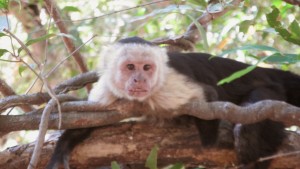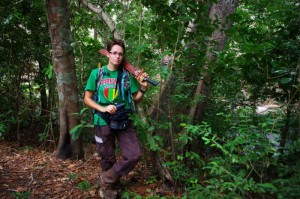Social Drama in the Workplace
by Joana Griciute
When I came to Costa Rica to spend a year working as a field assistant for a respected researcher and mentor Prof. Susan Perry, I wasn’t expecting to find social drama in the work place. I am very reserved, not-too-social person, so I find it hard sometimes to deal with lots of emotional conflict. And I try to not get involved. But I am not talking about human life this time, I am talking about monkeys. Yes, our fellow primates. And just so you know, I became involved.
Most primates are very social creatures. They live in small or large groups depending on the species, and they also have various group structures – fission-fusion society, one male/multi-female groups, and monogamous family groups – to name a few. White-faced capuchins live in multi-male/multi-female groups, and that makes their lives interesting to observe. At Lomas Barbudal, they live in groups from 6 to over 30 individuals. The more there are in the group, the more drama you are going to see, with a few exceptions.
 Celeste’s group consisted of seven monkeys at the time I arrived: Pitufo, the famous, fearless group leader and foraging master despite his handicapped condition (depicted below); Celeste, the alpha female, who was subordinate in her previous group, so she decided to create her own group; Newman, the old male, who has lived in 4 groups at some point in his life; Kalypso, Siberia and Voldemort, all daughters of Celeste; and Gambit, Kalypso’s daughter, the sweetest monkey I have even known. Celeste group was fairly newly formed, still having no set territorial boundaries, and was pushed away from good foraging spots by other groups quite often. Pitufo joined this group soon after Celeste and her daughters left their natal group (Abby’s group). Pitufo, having no other competitors, and being a gentlemen as he is, was accepted as the alpha male and worshiped by females. The social dynamics of this new group soon became really interesting.
Celeste’s group consisted of seven monkeys at the time I arrived: Pitufo, the famous, fearless group leader and foraging master despite his handicapped condition (depicted below); Celeste, the alpha female, who was subordinate in her previous group, so she decided to create her own group; Newman, the old male, who has lived in 4 groups at some point in his life; Kalypso, Siberia and Voldemort, all daughters of Celeste; and Gambit, Kalypso’s daughter, the sweetest monkey I have even known. Celeste group was fairly newly formed, still having no set territorial boundaries, and was pushed away from good foraging spots by other groups quite often. Pitufo joined this group soon after Celeste and her daughters left their natal group (Abby’s group). Pitufo, having no other competitors, and being a gentlemen as he is, was accepted as the alpha male and worshiped by females. The social dynamics of this new group soon became really interesting.
Pitufo’s brother Power was the alpha male of Cupie’s group, a tiny neighboring group that had lost all but one of its adult females (Chaos). This older, scar-faced male, was full of surprises and was an intriguing politician. The other members of Cupie’s group included Chaos, a quiet adult female, who was usually found at Power’s side. The subadult female Rawketskates was always on her own; no matter what was happening, she would always refuse to get involved. Ybobo and Erebus, two juvenile males, spent their days playfully chasing each other and not caring much about anything else. And there was also Havoc, the youngest member of the group.
The two groups didn’t interact much at first, but when the dry season came, and days were getting hotter, monkeys were spending more and more time on the banks of the rivers, resting in the safety of the shadows most of the time. This is the time of year when we observe most intergroup encounters (fights between two monkey groups) and when the data collection becomes most exciting and rewarding. Nothing makes you love your job more than running after fluffed up males chasing each other, threatening each other; trying to relocate the females and juveniles, who are masters at running away in such encounters; and shouting all of the happenings into your dictaphone, if you are able to ever catch your breath. We had a lot of those days with Celeste and Cupie groups. It was a very interesting dry season.
Power was challenging Pitufo in hopes of having more females in his group, but Pitufo, having all of the support of females and his friend Newman, was not going to give up. The odds were on Pitufo’s side, and he held his position with pride and dignity that I have never seen before. Later on, in the intergroup encounters, Cupie’s group would always run away and Celeste’s group was starting to explore more and more of the forest as their territory boundaries seemed to expand quite rapidly. Cupie’s group was on the losing end and the future of the group seem to be quite grim – with only one adult female and only one adult male, the group could not grow in numbers and compete effectively with the neighbors.
Then, one day, we saw what we thought was impossible: two groups joined together. Power stopped challenging Pitufo and accepted Pitufo as alpha male; Chaos was an outcast and no one seem to care about her much, except for her son Havoc, who would come to her and ask for grooming.
Females from Celeste’s group would often vent their frustration on Chaos and chase her away, making it clear that her presence was not welcomed in Celeste’s group. It was quite sad to observe those two monkeys becoming subordinates after being alfa animals, but such is monkey life. Ybobo and Erebus found their place in the new group quite easily and continued living their careless life as young males. Rawketskates was hard to understand: she seem to not care much one way or another.
The future for Celeste’s group seems to be very bright now that it has a stable alpha male, supported by two adult males and two juvenile males who will soon be old enough to be helpful in intergroup encounters. It is a healthy group structure, with several females who are reproducing and enough males to defend them from outsiders. I have no doubts that Celeste’s group will become a big and powerful ‘family’ in the Lomas Barbudal Nature Reserve.
Joana Griciute, a veterinarian from Lithuania, completed a year of volunteer work with the Lomas Barbudal Monkey Project in 2013 and has just returned to help the project for a few more months.





